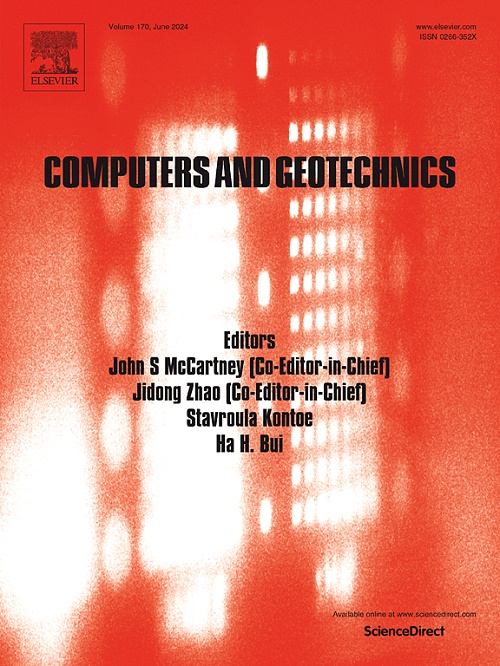Assessing direct CPT-based methods for predicting pile base resistance using coupled DEM-FDM simulations
IF 5.3
1区 工程技术
Q1 COMPUTER SCIENCE, INTERDISCIPLINARY APPLICATIONS
引用次数: 0
Abstract
This study utilises parallel discrete element method (DEM) simulations of cone penetration tests (CPTs) and pile load tests to investigate the application of direct CPT-based methods for predicting the base capacity of bored piles in layered soils. To reduce boundary effects, a coupled DEM-finite difference method (FDM) model is constructed to simulate pile load tests. The study focuses on the scale effect of pile diameter on the correction factor αb and the effectiveness of existing qc averaging methods in layered soils. Two pile diameters and three soil layering conditions, featuring a single silt layer interbedded within sand at varying depths, are considered in the simulations. Results show that both soil layering and pile displacement influence the scale effect. At small settlements (s) up to 0.3 times the pile diameter (D), the scale effect is insignificant, except when a soft layer is directly above the pile tip. At larger settlements, particularly when s > 0.5D, piles with smaller diameters show more pronounced reductions in base resistance due to a weak layer closely beneath the tip. Among the four methods evaluated, the BD-18 qc averaging method produces more consistent αb values across various soil profiles and pile diameters. Microscopic analysis reveals that soils above the tip contribute less to the pile base resistance at s/D = 0.1 than to the cone tip resistance. Additionally, the strength mobilisation levels of soils in most soil layering conditions appear similar at s/D = 0.1, supporting the proposal of a constant αb value in direct CPT-based methods.
利用耦合DEM-FDM模拟评估直接基于cpt的桩基阻力预测方法
本研究利用平行离散元法(DEM)模拟锥突试验(CPTs)和桩荷载试验,探讨直接基于离散元法的方法在层状土中钻孔灌注桩基础承载力预测中的应用。为了减小边界效应,建立了一种dem -有限差分法(FDM)耦合模型来模拟桩荷载试验。研究了层状土中桩径对修正系数αb的尺度效应以及现有qc平均方法的有效性。模拟中考虑了两种桩径和三种土层条件,即单粉土层与不同深度的砂土互层。结果表明,分层和桩身位移都对尺度效应有影响。在小于0.3倍桩径(D)的小沉降(s)中,除桩端正上方有软土层外,尺度效应不显著。在较大的定居点,特别是当s >;0.5D时,直径越小的桩,由于在桩端下方有一层较弱的桩基阻力,桩基阻力降低越明显。在四种评价方法中,BD-18 qc平均法在不同土型和不同桩径下得到的αb值更为一致。细观分析表明,s/D = 0.1时,桩端以上土体对桩基阻力的贡献小于对桩端阻力的贡献。此外,在s/D = 0.1时,大多数分层条件下土壤的强度动员水平相似,支持直接基于cpt的方法中αb值恒定的建议。
本文章由计算机程序翻译,如有差异,请以英文原文为准。
求助全文
约1分钟内获得全文
求助全文
来源期刊

Computers and Geotechnics
地学-地球科学综合
CiteScore
9.10
自引率
15.10%
发文量
438
审稿时长
45 days
期刊介绍:
The use of computers is firmly established in geotechnical engineering and continues to grow rapidly in both engineering practice and academe. The development of advanced numerical techniques and constitutive modeling, in conjunction with rapid developments in computer hardware, enables problems to be tackled that were unthinkable even a few years ago. Computers and Geotechnics provides an up-to-date reference for engineers and researchers engaged in computer aided analysis and research in geotechnical engineering. The journal is intended for an expeditious dissemination of advanced computer applications across a broad range of geotechnical topics. Contributions on advances in numerical algorithms, computer implementation of new constitutive models and probabilistic methods are especially encouraged.
 求助内容:
求助内容: 应助结果提醒方式:
应助结果提醒方式:


